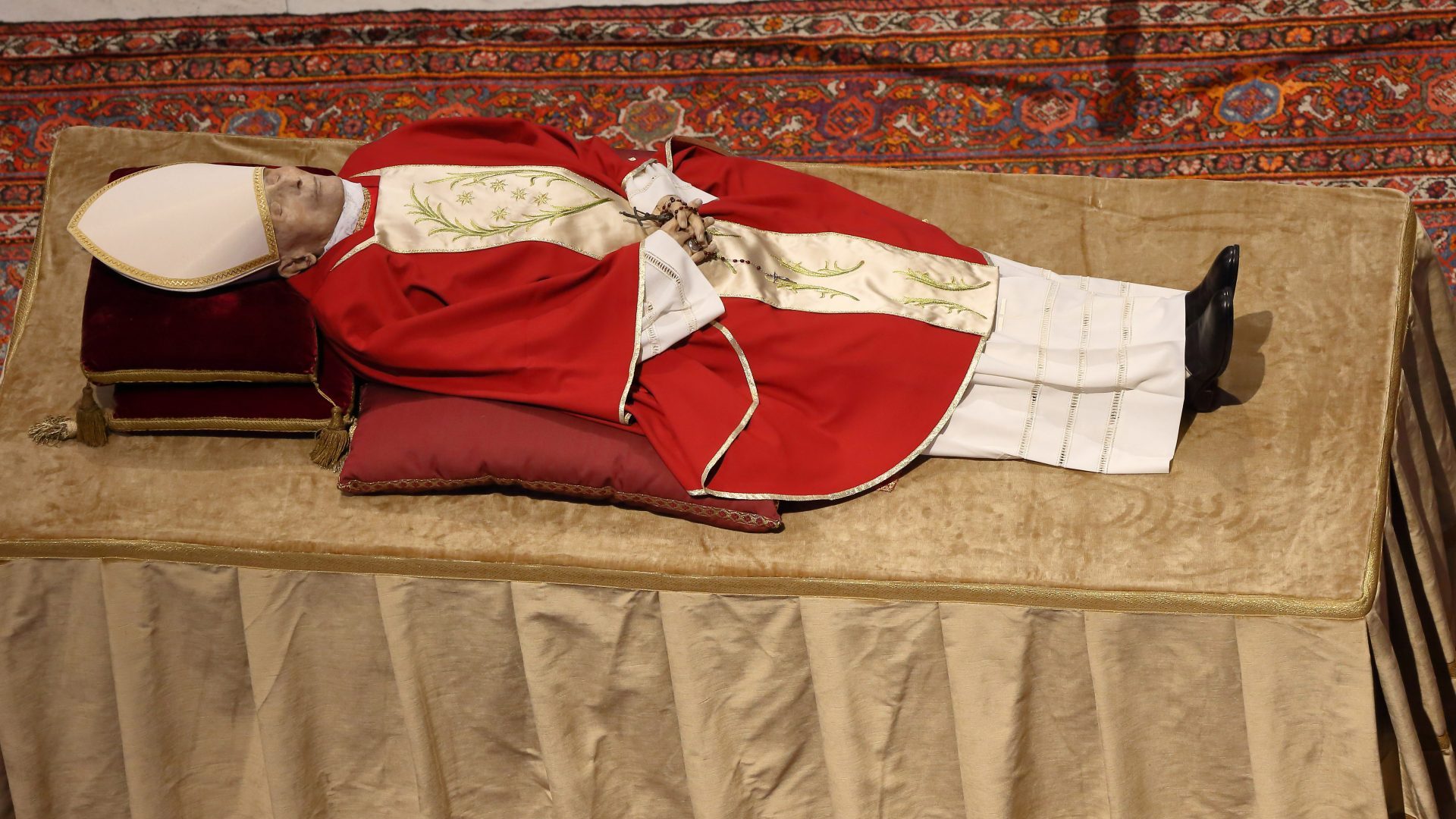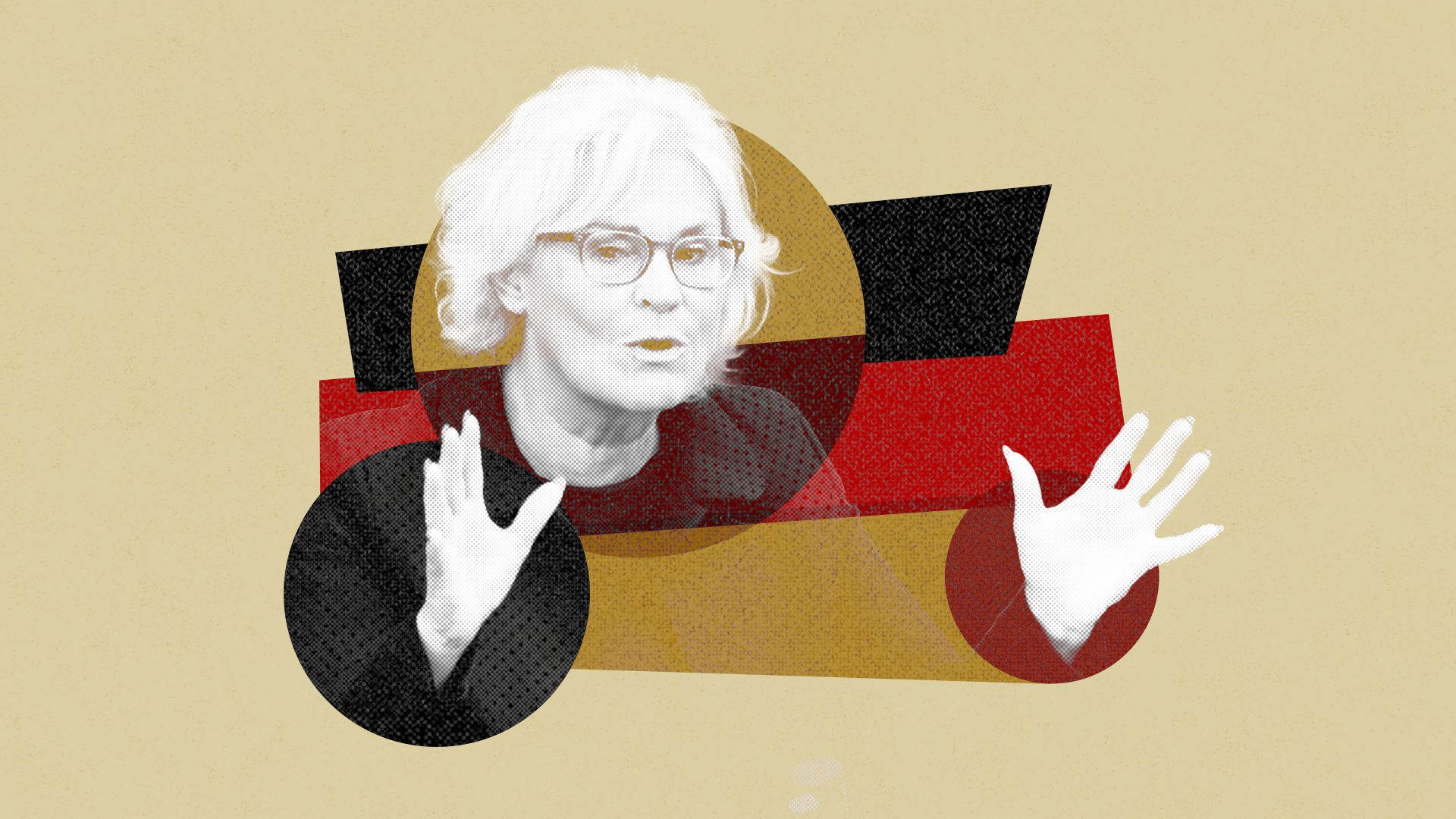Cries of “Santo Subito” (“Sainthood now”) rose from the crowd into the fog shrouding St Peter’s Square at the end of an unprecedented funeral for a pope emeritus whose life and death broke the mould in this most traditional of institutions.
In 2013, Pope Benedict XVI became the first pope in 600 years to resign, and this month, his successor Pope Francis became the first pope in modern times to bury his predecessor. Although Benedict’s reign as leader of the Catholic Church was long over, his funeral was still rich with the extravagant touches that usually mark the departure of the person seen by Catholics as God’s representative on earth.
From the moment a pope draws his last breath, tradition takes over. The Ring of the Fisherman is taken from the dead man’s finger and crushed with a ceremonial silver hammer in the presence of members of the College of Cardinals. Normally, this is the start of an elaborate transition that ends with the appearance of white smoke over the Sistine Chapel to signify the choice of a new pope by the papal conclave of cardinals.
The guidelines for papal funerals are laid out in a 400-page Vatican handbook called Funeral Rites of the Roman Pontiff, which includes liturgy, music and prayers. The funeral takes place between the fourth and sixth days after death, although the pontiff is celebrated for nine consecutive days, a period known as the novendiales. Usually, the body lies in state in the Vatican for three days. The corpse is placed in a cypress wood coffin, meant to signify humility and refer to the fact that the pope was an ordinary man first.
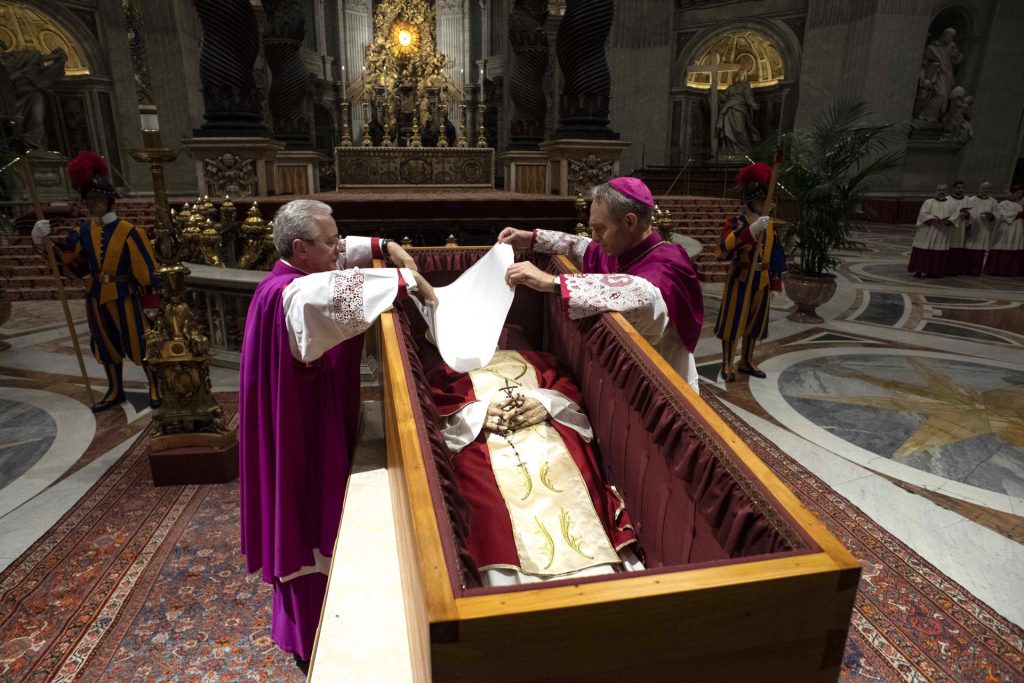
Papal items, including palliums, or lambswool stoles, coins and medals minted during the individual’s pontificate, are also placed in the casket. The number of coins in each bag equals the number of years of the individual’s papacy. A lead tube with a deed, or rogito, which lists the pontiff’s key biographical details and achievements in Latin, is also placed in the coffin.
Before the coffin is sealed and wrapped in silk ribbons, a white silk veil is placed over the face of the pope in a tradition started by Leo XIII, who was pope from 1878 to 1903. The cypress coffin is then placed inside a zinc casket adorned with a cross, the pope’s name, the years of his papacy and his personal coat of arms. The zinc coffin is then placed inside a wooden – often oak, walnut, or elm – casket, which is shut with nails of gold.
The multiple coffins are hermetically sealed to create an airtight barrier and prevent moisture from entering. This preserves the body for longer than a traditional wooden coffin would.
Most popes who have died in the modern era have been embalmed, including Pius XII, John XXIII, Paul VI, and John Paul I. The Signoracci family – operators of Rome’s leading mortuary – had for generations prepared popes for burial. However, they never received a call when John Paul II died in 2005 and the Vatican said the pontiff was not embalmed; observers did note that his body looked grey as it lay in state
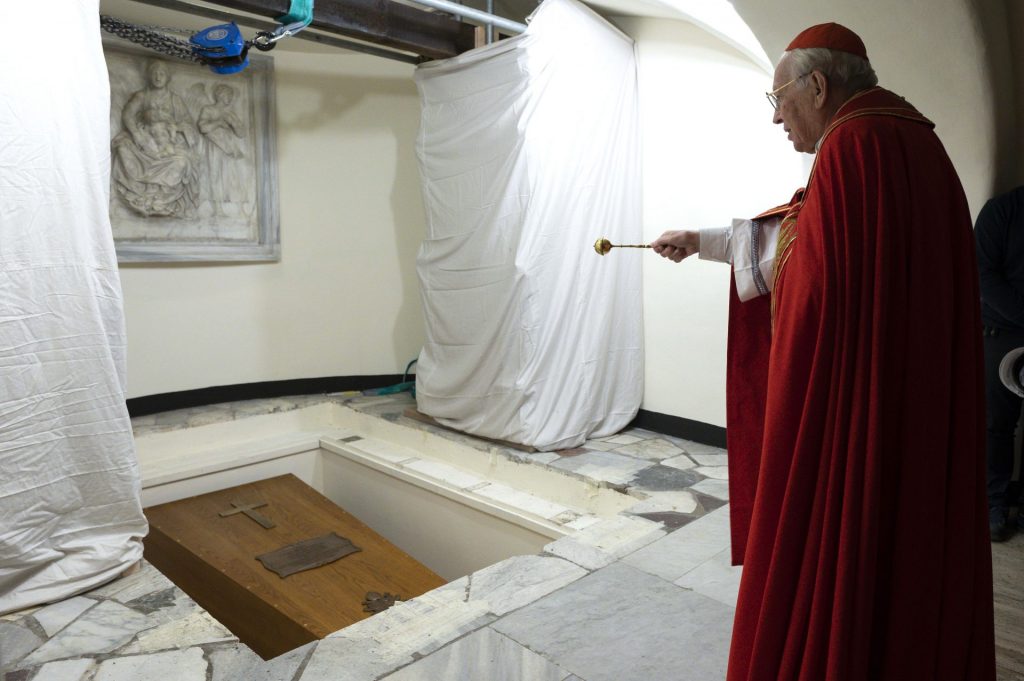
The body of his predecessor-but-one, Paul VI, who died in August 1978, was only lightly embalmed and was said to have taken on “a greenish tinge” as it lay in the hot and humid summer air: fans were installed in the Basilica to disperse the smell.
In 2005, Massimo Signorracci explained to Der Spiegel that embalming was a relatively simple process, saying: “You just open up the arteries in the neck and groin, pump the blood out and, at the same time, inject the embalming fluid into the veins.”
But the process has clearly been controversial. The speedy embalming of Paul VI’s successor, John Paul I, who died after just 33 days in office and was known as the Smiling Pope, fuelled speculation that his death was not from natural causes, feeding into conspiracy theories that he was a victim of foul play.
When John XXIII, the “Good Pope” who died in 1963, was disinterred in 2001, his body seemed in good shape – a source of pride for the Signoracci family and a sign of the soon-to-be saint’s holiness for the Catholic faithful.
But by far the worst embalming experience took place in 1958, when a maverick Italian doctor, Riccardo Galeazzi-Lisi, persuaded the Vatican to let him try an experimental embalming technique on the body of Pope Pius XII, with disastrous consequences — the body started decomposing and the smell was so bad that members of the Swiss Guard reportedly fainted while standing guard around the coffin. Eventually, the stomach was so bloated with gases that it actually exploded during the funeral procession.
Historically, organs were removed to make the embalmed bodies more durable and relics of 22 popes are kept in Rome’s Saint St Anastasio and Vincent Church near the Trevi fountain in Rome. But Pope Pius X, who headed the Catholic Church from 1903 to 1914, eliminated the custom.
After their bodies are prepared, deceased popes are dressed in a white soutane, a plain white alb and a red chasuble – under an ancient Byzantine custom, red is the colour of mourning for popes. During the funeral, the casket is carried by papal gentlemen, lay attendants of the papal household. Then traditionally the coffins – which can weigh close to a half a tonne – are carried through the “door of death” on the left side of the main altar in the Basilica as a single bell tolls.
Sitting popes can say where they want to be buried, and most have chosen St Peter’s Basilica. A plaque on the wall indicates that 148 popes – out of 266 – have been buried there, although some of those were subsequently moved. Today, the remains of 91 popes are in the Vatican Grottoes, a warren of tombs below the church, while those who have been sainted have more prominent spots within the Basilica.
Benedict was buried in the first tomb of his predecessor, John Paul II, on the north side of the Grottoes, less than 100 feet from the tomb of St Peter. This had previously been the resting place of John XXIII, who was moved to the St Jerome Altar in the basilica in 2001 after he was declared blessed. John Paul II’s body was moved upstairs to beneath the Altar of St Sebastian after he himself was beatified in 2011, leaving the space below free for his successor.
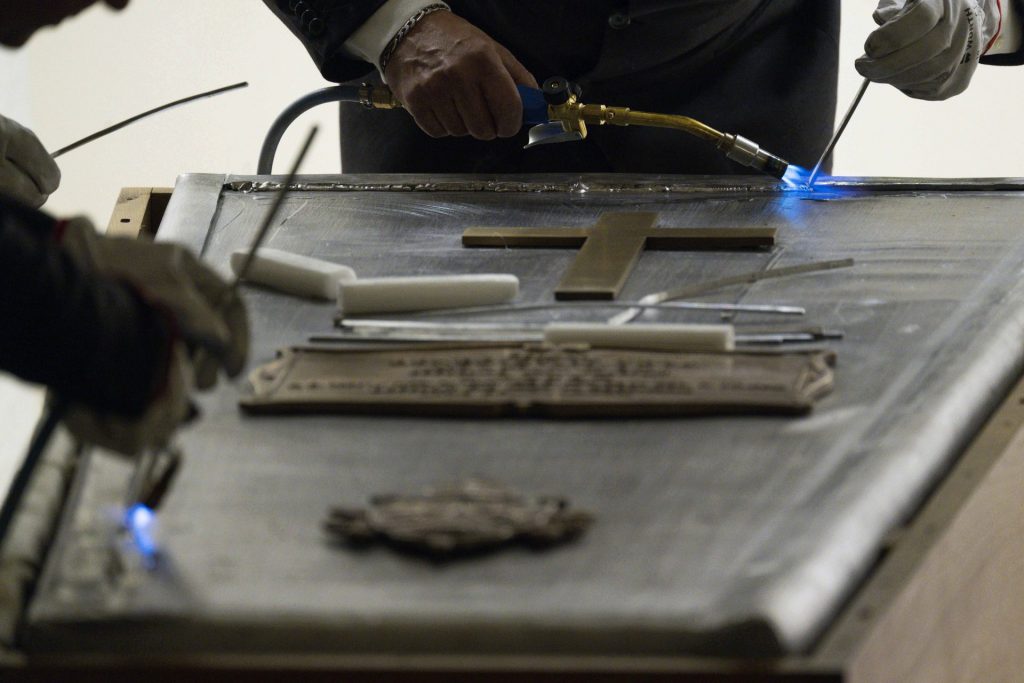
While the sight of a pope presiding over the funeral of another pontiff as Pope Francis did for Benedict on January 5 was unique in the modern age, there is a precedent: in 1802, Pope Pius VII presided over the funeral in St Peter’s of his predecessor Pius VI, who had died in exile in France in 1799 as a prisoner of Napoleon. Pope Pius VII wanted his predecessor’s remains to be brought back to Rome and so they were exhumed in 1801, and travelled from Valence to Marseilles and from there, by ship, to Genoa. Then, the remains were carried on a triumphal pilgrimage to Rome.
While papal funeral rites are sober, highly ritualised affairs today, it has not always been the case. When Alexander VI died of suspected malaria in Rome in 1503, his body was displayed to the people and clergy of the city covered by an “old tapestry” to hide its rapid decomposition. The Venetian ambassador apparently said the body was “the ugliest, most monstrous and horrible dead body that was ever seen, without any form or likeness of humanity”.
Pope Formosus (pontiff from 891 to 896) had an even worse fate. After his death, his body was exhumed to face trial by a successor Stephen VI, who had it dressed in pontifical robes and placed on the throne to face charges of perjury and other crimes – this was known as the Cadaver Synod. When he was found guilty, the three fingers that Formosus had used to deliver blessings were hacked off and his body was dragged through the streets of Rome before being thrown into the Tiber River. Somewhat unsurprisingly, the supporters of Formosus then imprisoned Stephen VI, stripped him of his papal insignia and strangled him to death.


